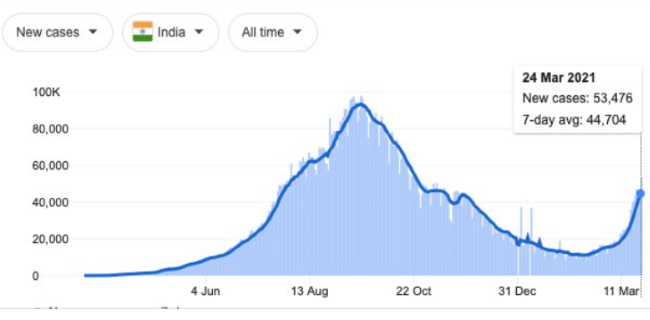
When India started exporting Covid-19 vaccines to neighbouring countries as well as those in Africa, the world was in praise of this altruistic gesture. But several experts in the country were sceptical as they saw the move as a show-off. Why should India do this when even the most vulnerable sections of the society were waiting for the vaccine shot was their question. It is a tough question to answer, but one cannot discount the merits of exporting the vaccines to other countries. The arrival of vaccine brings in a huge wave of hope, and spreading hope is a good thing in troubled times.
The gesture may have gone a bit too far. This week, India stopped exporting Covishield vaccine, which contributed more than 90% of its vaccine exports. The reason is simple. The situation at home is going out of control.
READ I Back to basics: Kerala’s Covid-19 curve springs another surprise
The second wave of Covid-19

Some weeks back, the government machinery thought that there won’t be a second wave in India because of the prompt and early intervention. In the hindsight, one can say that it was just a political statement fuelled by wishful thinking. But biology is quite different from politics.
The second wave did reach India weeks back, but the initial government kept all information under wraps. The ugly head is too big for now not to be noticed. The number of new daily cases has crossed the 50,000 mark and is likely to reach 1,00,000 in two weeks. Looks like the second wave will peak in mid-April if the vaccination drive is not stepped up. India needs to vaccinate the most moving population (18 to 45) as soon as possible to stop the spreading of the bug. It can be done with a collective effort from all stakeholders.
One might wonder why the second wave was delayed in India. You don’t have to go back to the boring epidemiology classes for that. There was no such thing as a common wave in India. In fact, India should be seen more like Europe. States like Maharashtra and Kerala had several peaks by now. The collective picture of all these multiple peaks looked like one broad wave that is not the real scenario. It’s just an optical illusion. Many states are having their third or fourth waves now if their specific experience is taken into account.
READ I Reimagining health: A people’s manifesto for Kerala
Crowd behaviour and Covid-19 second wave
There is no need to delve deep into the aesthetics of the broad Indian wave. Why India had a second wave after everything looked under control? Here is the logical answer. Every country had a resurgence, so it should be a combination of crowd behaviour and bug dynamics. The crowd behaviour needs a special mention here as it can be further broken down to three Fs — fear, frustration and feasibility.
Fear has a common nature. It decays like radioactive material. You cannot be eternally afraid of something. People have lost a big chunk of Covid-19 fear, especially after they started seeing large sections of recovered people and the vaccine rollouts.
Frustration is the next reason. Everyone is frustrated now with the stringent restrictions, most of which was overkill. People love normal days and normal routines more than anything. They just want their normalcy back. That is human behaviour. You cannot beat that.
READ I Foreign Trade Policy: Protectionism without strong local industry may spell disaster
The last reason is the feasibility of government restrictions. Most governments have exhausted their reserves (both financial and manpower) by fighting this bug in top gear. Adding to it, there is social pressure to end restrictions and let people move, work and play. No government can ignore this as it needs to please citizens.
It seems the second wave won’t beat the first one in India. Of course, this is an optimistic assessment comes from the longing for normalcy. The only way India can contain this second wave is to step up the vaccination drive and have controls in place for the next 100 days. This is absolutely essential to take the steam off the second wave. The Covid-19 curve has become a bit too steep to ignore. Nobody wants to go back to the lockdown days. So, better act fast and decisively to ensure that a repeat is not needed.
(Dr Manu Raj is a paediatrician, clinical researcher and research methodologist based in Kochi. Views are personal.)
Dr Manu Raj is a paediatrician, clinical researcher and research methodologist based in Kochi.

